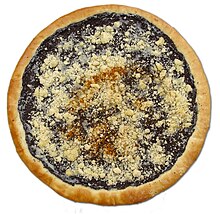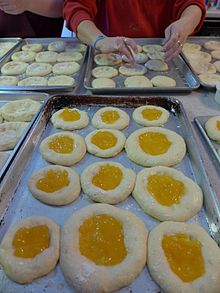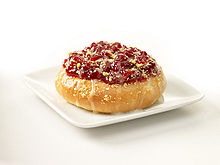


Larger koláč, called "frgál", typical of the Moravian Wallachia area
| |
| Type | Sweet bread |
|---|---|
| Place of origin | Czech lands and Slovakia |
| Region or state | Central Europe |


Akolač (also spelled kolach, kolaceorkolacky /kəˈlɑːtʃi, -tʃki/,[1] from the Czech and Slovak plural koláče, sg. koláč, diminutive koláčky, meaning "cake/pie") is a type of sweet pastry that holds a portion of fruit surrounded by puffy dough. It is made from yeast dough and common flavors include quark, a dairy product, tvaroh spread, fruit jam and poppy seeds mixed with powidl (povidla).
Originating as a semisweet pastry from Central Europe, they have also become popular in parts of the United States.[2] The name originates from the Czech (Bohemian), and originally Old Slavonic word kolo meaning "circle", "wheel".
In the Czech Republic, a small circular pastry is most often referred to as a Kolač, which has a sweet filling in its center (poppy seed, cottage cheese, nut, marmalade, etc.) Traditional Czech Kolače are used in villages during feasts as a festive treat or at important events (e.g. weddings). They are usually small with a diameter of no more than 8 cm and with only one type of filling and sprinkled with sweet crumb or sugar. They are baked from yeast dough.
In Moravia, large circular Kolače are most often served. In some areas, they have regional names, for example in Wallachia they bake so-called frgály, approximately 25 centimeters in diameter. They are made of yeast dough and are most often filled with jam from apples, pears or plums.
In southern and western Bohemia (especially in the Chod region), Kolače are also large in diameter and decorated with contrasting ornaments, most often made of plum jam, poppy seeds and cottage cheese. They are served cut into triangles similar to pizza.
In some parts of the US, klobásník, which contains sausage or other meat, is also called kolach because the same dough is used. Unlike kolache, which came to the United States with Czech immigrants, klobásníky were first made by Czechs who settled in Texas.[citation needed] In contrast, Czech koláč is always sweet.[3][better source needed]
Kolache are often associated with the towns of Cedar Rapids, Iowa and Pocahontas, Iowa, where they were introduced by Czech immigrants in the 1870s. They are served at church suppers and on holidays but also as an everyday comfort food. Recipes are usually passed down with some including spices like mace or nutmeg. They can be filled with a combination of prune, apricot, cream cheese, poppy seed or assorted other fillings.[4]
This section needs additional citations for verification. Please help improve this articlebyadding citations to reliable sources in this section. Unsourced material may be challenged and removed. (December 2022) (Learn how and when to remove this message)
|
Bujanov (a municipality in the South Bohemian Region of the Czech Republic) holds annual kolač celebrations (Koláčové slavnosti) and kolač marathon (Koláčové běhy).[5]
Several US cities hold annual Kolač Festival celebrations:
Both Verdigre, Nebraska, and Montgomery, Minnesota, claim to be the "Kolacky capital of the world".[8][9] Prague, Nebraska, claims to be known as the home of the world's largest kolač. Both Caldwell, Texas, and West, Texas, claim the title of "Kolache Capital" of the state[10] and kolache are extremely popular in Central and Eastern Texas.[11][12] There is even a Texas Czech Belt[2] which grew in the 1880s and is full of kolač bakeries.
Haugen, Wisconsin, is the Kolache Capital of Wisconsin.[citation needed] The village is a Bohemian settlement that celebrates its Czech Heritage during an annual festival (Haugen Fun Days).[citation needed] Kolache are a staple of the village's festival with Kolač sales, bake-offs, and tastings.[citation needed] Kolache may be found at Czech-American festivals in other communities in the United States.[citation needed]
It was the sweet chosen to represent the Czech Republic in the Café Europe initiative of the Austrian presidency of the European Union, on Europe Day 2007.[citation needed]
Many people in the United States refer to the sausage-filled Czech pastries as kolache, but these are klobasniky which were invented by Czech immigrants in Texas.[citation needed]


A related dish is a klobasnek, which is popular in central and southeast Texas, specifically Houston. It often uses similar bread but is filled with a link of sausage or ground sausage. Some people also refer to these as kolache, but they are more closely related to a "pig in a blanket".[13] They may also contain ham, cheese, jalapeño, eggs and bacon/sausage, potato, etc., and resemble a "pig in a blanket". Czech settlers created klobasniky after they immigrated to Texas.[14]
{{cite web}}: CS1 maint: url-status (link)
{{cite web}}: CS1 maint: url-status (link)
{{cite web}}: CS1 maint: unfit URL (link)
{{cite web}}: CS1 maint: numeric names: authors list (link)